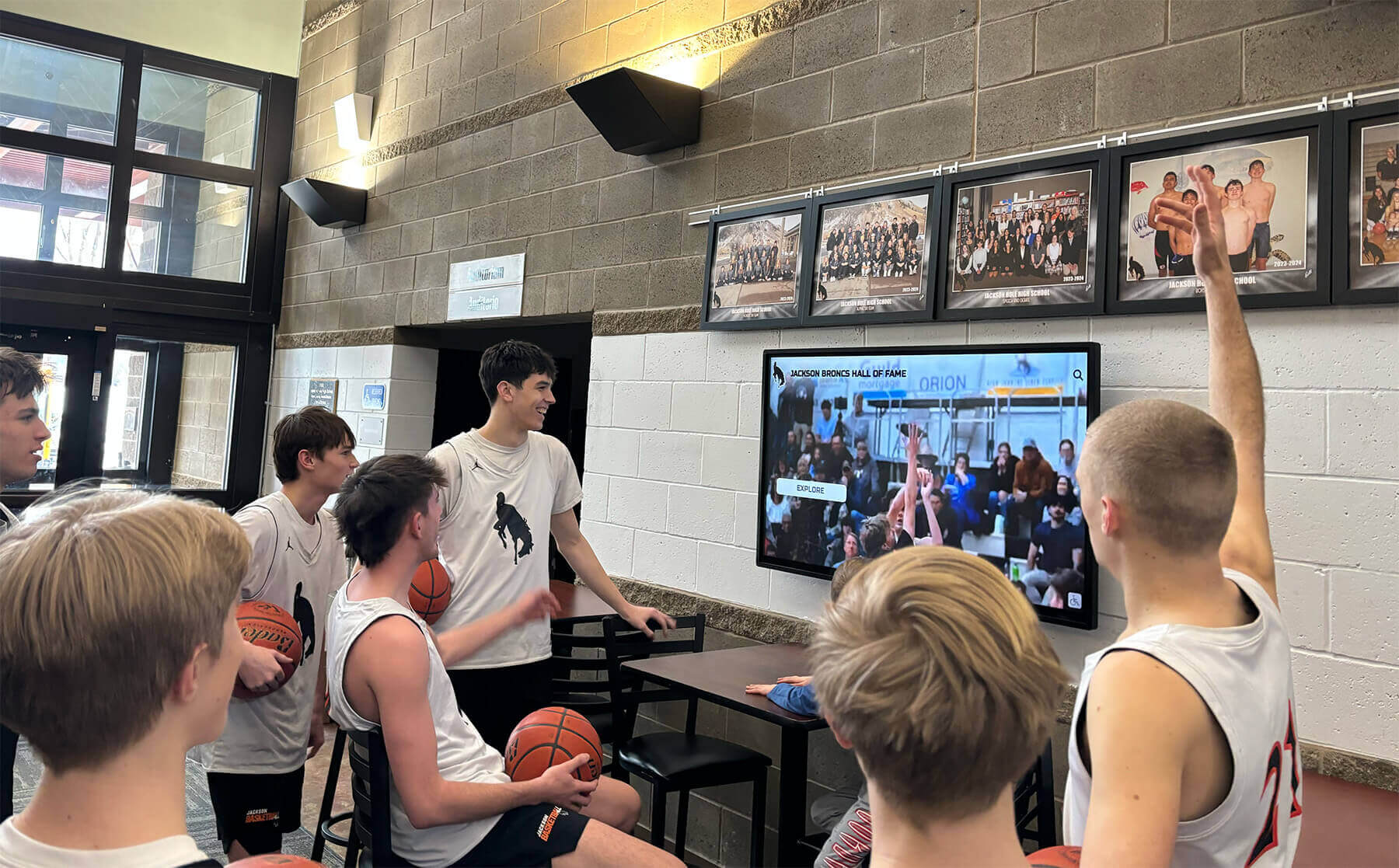Key Takeaways
Comprehensive guide to creating high school basketball alumni displays that honor program legends, inspire current players, and preserve court excellence through modern digital recognition systems.
Why High School Basketball Alumni Displays Matter
Basketball alumni displays serve multiple strategic purposes that strengthen programs, connect generations, and build institutional identity around court excellence.
Preserving Program History and Legacy
High school basketball programs accumulate rich histories spanning decades—legendary coaches who built winning traditions, dominant teams that captured championships, individual stars who set records, and countless athletes who contributed to program success. Without systematic preservation and display, these stories gradually fade as graduates move on, coaches retire, and memories become less accessible.
Historical Documentation Challenges:
Traditional approaches to basketball history preservation face significant limitations:
- Physical record books gathering dust in athletic director offices
- Faded newspaper clippings deteriorating in storage
- Scattered team photos across yearbooks and personal collections
- Oral histories existing only in the memories of alumni and coaches
- Statistical records maintained inconsistently across different eras
- Championship banners displaying only minimal information
Comprehensive alumni displays solve these challenges by creating centralized, accessible repositories of program history. When a current sophomore can explore detailed profiles of 1980s All-State players, watch video highlights of championship games from the 2000s, and see complete statistical breakdowns of record holders across multiple decades, program history becomes tangible and relevant rather than abstract and forgotten.

Inspiring Current Players Through Visible Success
Basketball players respond powerfully to seeing proof that athletes before them achieved extraordinary success while wearing the same uniform. Alumni displays create aspirational benchmarks that transform abstract concepts of excellence into concrete, achievable goals.
Motivation Through Recognition:
When current players regularly encounter alumni displays, several psychological effects drive improved performance and commitment:
- Goal Crystallization: Seeing specific achievements (1,000 career points, All-Conference selection, state championship participation) gives players clear targets to pursue
- Pathway Visualization: Profiles showing how previous players developed from freshmen through senior years demonstrate that sustained effort produces recognition
- Identity Connection: Understanding they’re part of continuous tradition connecting past legends with future stars strengthens commitment to program values
- Competitive Drive: Knowing their achievements could earn similar permanent recognition creates healthy motivation to excel
- Role Model Accessibility: Detailed alumni profiles provide specific examples of excellence more relatable than professional athletes
Research on athletic motivation demonstrates that visible recognition of past achievement significantly impacts current athlete goal-setting behavior and performance outcomes. Players who regularly interact with comprehensive athletic recognition displays report higher program pride, stronger performance motivation, and clearer development goals compared to those in programs without prominent alumni recognition.
Strengthening Alumni Connections and Engagement
Basketball alumni who feel valued through continued recognition maintain stronger connections to programs throughout their lives. These connections translate into numerous program benefits beyond simple nostalgia.
Alumni Engagement Benefits:
Effective basketball alumni displays create ongoing touchpoints for graduated players:
- Reunion Attendance: Alumni return for homecoming and special events where they explore their own recognition and reconnect with program history
- Mentorship Opportunities: Recognized alumni volunteer as coaches, speakers, and mentors for current players
- Financial Support: Alumni who feel valued contribute more readily to fundraising campaigns, booster programs, and facility improvements
- Recruiting Assistance: Former players help recruit next generation talent by sharing positive program experiences
- Network Building: Recognition creates natural conversation starters connecting alumni across graduation years
- Program Advocacy: Engaged alumni become ambassadors promoting program reputation in communities and workplaces
Schools implementing comprehensive digital alumni recognition systems report 40-60% increases in alumni engagement metrics including event attendance, volunteer participation, and financial contributions compared to programs relying solely on traditional recognition methods.
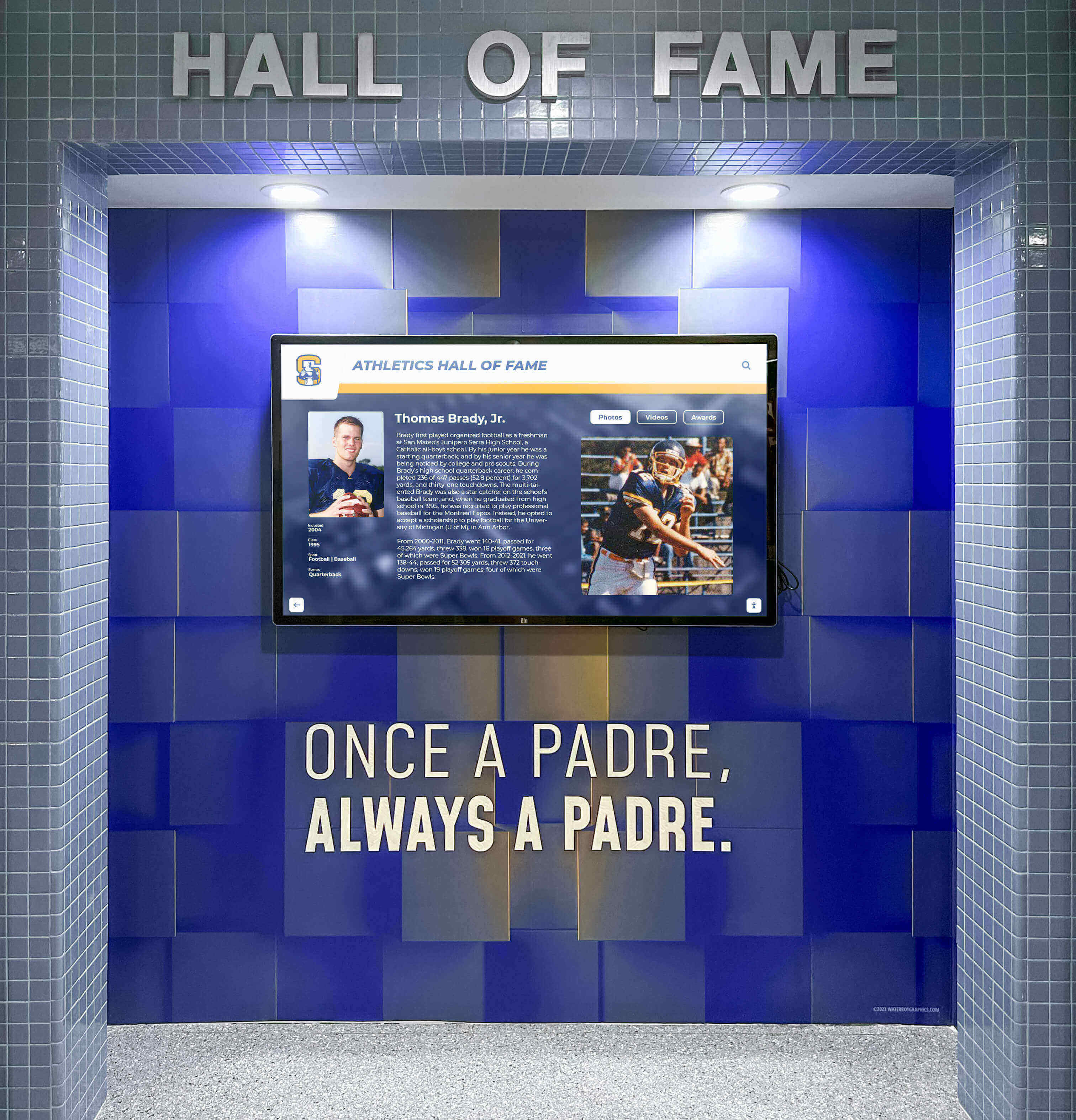
Traditional vs. Modern Basketball Alumni Display Approaches
Understanding limitations of conventional recognition methods illuminates why schools increasingly transition to modern digital solutions for basketball alumni displays.
Traditional Physical Display Methods
Trophy Cases and Physical Plaques:
Generations of high schools have recognized basketball alumni through physical installations:
- Wall-mounted plaques listing All-State selections and championship team rosters
- Trophy cases displaying awards, championship trophies, and memorabilia
- Retired jersey displays honoring exceptional athletes
- Physical “hall of fame” installations with engraved plates or framed photos
- Banner displays hanging from gymnasium walls and ceilings
These traditional approaches provide permanent, tangible recognition that creates visual impact in athletic facilities. However, they also impose significant constraints limiting recognition effectiveness.
Space Limitations:
Physical displays face inherent space constraints creating difficult prioritization decisions:
- Finite wall space forcing choices about which athletes receive recognition
- Trophy cases filling up requiring removal of older items to accommodate new achievements
- Banner displays creating cluttered environments when programs have extensive success
- No room to expand recognition as programs continue developing championship traditions
Many athletic directors report struggling with these exact challenges—wanting to recognize deserving athletes but lacking physical space to do so appropriately. Some schools reach points where they must remove older recognition to make room for current achievements, creating unfortunate decisions about whose recognition gets archived or eliminated.
Limited Information Capacity:
Physical plaques and displays accommodate minimal information:
- Name, year, and basic achievement designation
- Perhaps a photo if space allows
- No room for career statistics, game highlights, or personal stories
- Impossible to provide context about achievements or program history
- No way to show video content or hear from alumni themselves
This information poverty prevents displays from telling complete stories about alumni achievements. A plaque listing “John Smith, 1,000 Point Scorer, Class of 2015” documents the achievement but fails to capture the journey, showcase the athlete’s personality, or inspire through detailed storytelling.
Update Challenges and Costs:
Maintaining physical displays creates ongoing operational burdens:
- New plaques typically cost $150-500 each for engraving and materials
- Installation requires coordination, tools, and often professional assistance
- Updates take weeks or months from achievement to displayed recognition
- Errors or corrections require complete plaque replacement
- Physical deterioration demands periodic maintenance and restoration
Schools using digital recognition systems eliminate these recurring costs while dramatically reducing time from achievement to recognition from weeks to minutes.
Modern Digital Basketball Alumni Displays
Digital recognition platforms address traditional limitations while introducing capabilities impossible with physical approaches.
Unlimited Recognition Capacity:
Digital systems accommodate unlimited alumni profiles without space constraints. Whether recognizing 50 athletes or 500, the physical footprint remains constant. Schools can honor every All-State player, championship team member, 1,000-point scorer, and program record holder from throughout history—giving equal prominence to 1970s legends and current season standouts.
Rich Multimedia Content:
Digital platforms enable comprehensive alumni profiles including:
- Multiple high-resolution photos from playing career and current life
- Career statistics with season-by-season breakdowns
- Video highlights of memorable performances and championship moments
- Audio or video interviews where alumni reflect on experiences
- Written narratives telling complete achievement stories
- Post-graduation accomplishments including college careers and professional success
- Social media integration enabling alumni to share their recognition
This multimedia richness transforms simple documentation into engaging storytelling that creates emotional connections with viewers.
Instant Updates and Corrections:
Cloud-based content management enables immediate updates from any internet-connected device:
- New alumni profiles published within minutes of achievement
- Career statistics updated in real-time as records progress
- Corrections implemented instantly without physical replacement costs
- Seasonal content refreshes highlighting relevant alumni
- Alumni themselves can submit updates about post-graduation achievements
Interactive Exploration:
Touchscreen interfaces invite active engagement through:
- Search functions finding specific athletes, years, or achievements instantly
- Filtering by graduation decade, achievement type, or position played
- Statistical comparisons between alumni across different eras
- Photo and video gallery browsing
- Detailed profile exploration with unlimited information depth
Research demonstrates that interactive digital displays increase visitor engagement duration by 400-600% compared to static physical displays, with viewers spending 4-6 minutes actively exploring digital content versus 30-60 seconds glancing at physical displays.
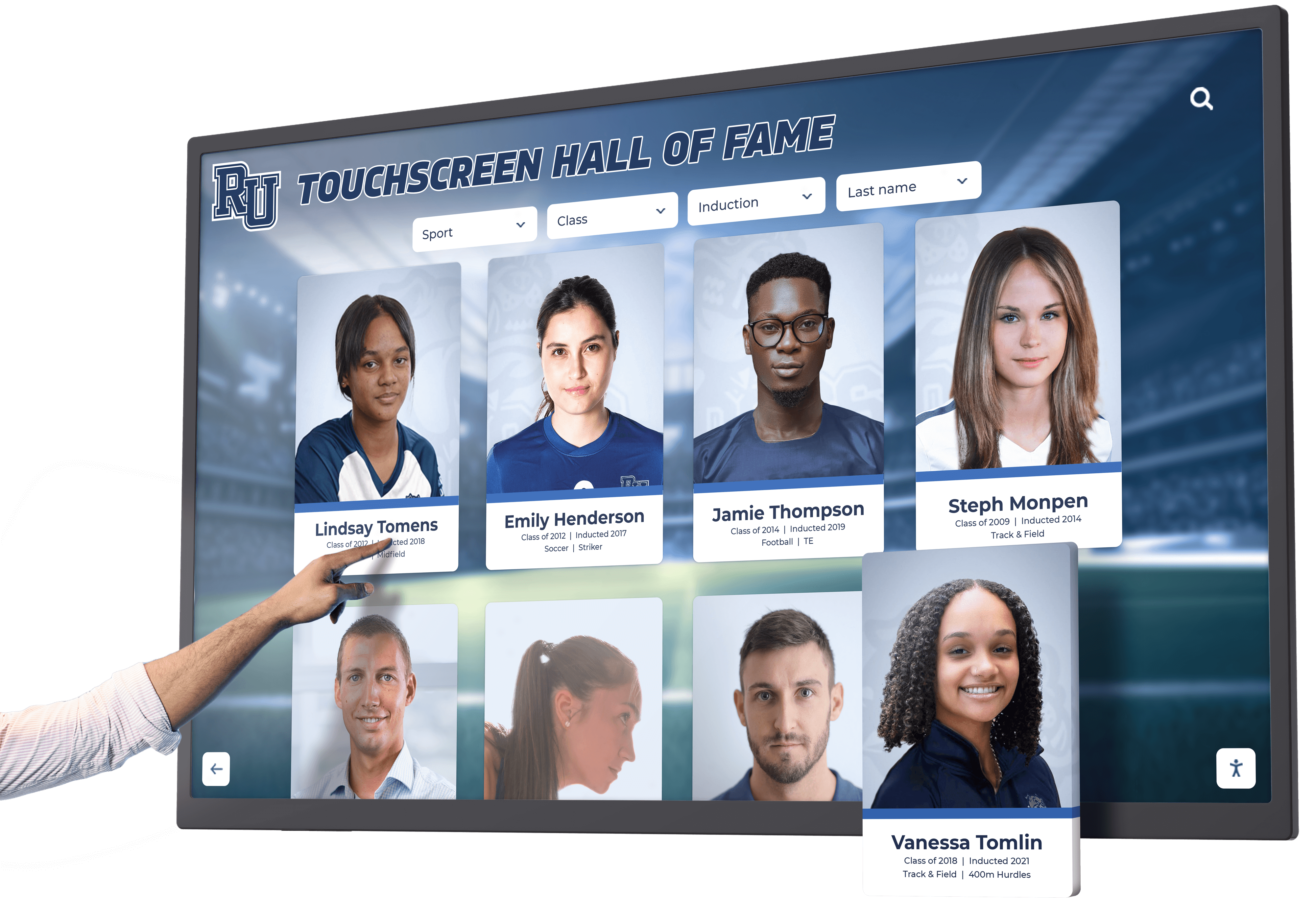
Essential Categories for Basketball Alumni Recognition
Comprehensive displays recognize diverse achievements beyond simple scoring statistics, celebrating excellence across multiple dimensions of basketball success.
Individual Scoring and Statistical Excellence
1,000-Point Scorers:
Reaching 1,000 career points represents one of basketball’s most prestigious individual achievements at the high school level. This milestone typically requires 3-4 years of varsity excellence, consistent scoring production, and durability across complete high school careers.
Recognition for 1,000-point scorers should include:
- Career point totals and points-per-game averages
- Season-by-season statistical progressions
- Notable single-game scoring performances
- Shooting percentages and three-point accomplishments
- Team success during their careers
- Post-graduation basketball achievements
All-Time Leading Scorers:
Program career scoring leaders deserve special recognition highlighting their place atop statistical history. Display all-time scoring lists showing top 10-20 scorers with complete career statistics, contextual information about different eras, and multimedia content celebrating their achievements.
Additional Statistical Categories:
Comprehensive programs recognize excellence beyond scoring:
- Career rebounding leaders demonstrating board dominance
- Assists leaders facilitating team offensive success
- Steals and defensive achievement recognition
- Three-point shooting records for long-range excellence
- Free throw percentage leaders showing consistency
- Double-double and triple-double achievements
Championship Teams and Collective Success
Conference Championships:
Conference titles represent sustained excellence over complete seasons. Recognition should document:
- Championship year and final conference record
- Complete team rosters with statistics
- Key games and memorable moments during title runs
- Coaching staff who led championship teams
- Season narratives explaining paths to championships
State Tournament Achievements:
Tournament success merits prominent celebration:
- State championship teams with complete documentation
- Regional and sectional championship teams
- Deep tournament runs reaching semifinals or finals
- Upset victories over higher-seeded opponents
- Tournament MVP and individual honor recipients
Implementing comprehensive championship recognition displays ensures collective achievements receive appropriate celebration alongside individual honors.
Season Excellence:
Recognize extraordinary seasons even without championships:
- Undefeated or single-loss regular seasons
- Longest winning streaks in program history
- Highest team winning percentages
- Most combined wins in a season
- Perfect conference records
Post-Graduation Success and College Advancement
College Basketball Careers:
Alumni playing at collegiate levels demonstrate program development quality:
- Complete rosters of alumni who played college basketball
- Division levels (D-I, D-II, D-III, NAIA, Junior College)
- College career statistics and achievements
- Conference championships and tournament appearances
- Academic All-American and Scholar-Athlete honors
- Post-college coaching or basketball involvement
Professional and International Careers:
Exceptional alumni reaching professional ranks deserve special recognition:
- Professional leagues played (NBA, G-League, overseas)
- Career highlights and achievements
- Current involvement in basketball
- Return visits and program support
Leadership, Character, and Academic Excellence
Team Captains and Leaders:
Leadership transcends statistics and deserves recognition:
- Team captain designations across program history
- Leadership awards and character recognition
- Sportsmanship honors
- Community service contributions
- Mentorship of younger players
Academic Achievement:
Well-rounded recognition celebrates classroom success:
- Academic All-State and All-Conference selections
- Honor roll athletes maintaining excellence in basketball and academics
- National Honor Society members
- Scholarship recipients for academic and athletic achievement
- Post-graduation educational accomplishments
Programs implementing comprehensive recognition systems create inclusive cultures valuing diverse contributions rather than focusing exclusively on scoring prowess.
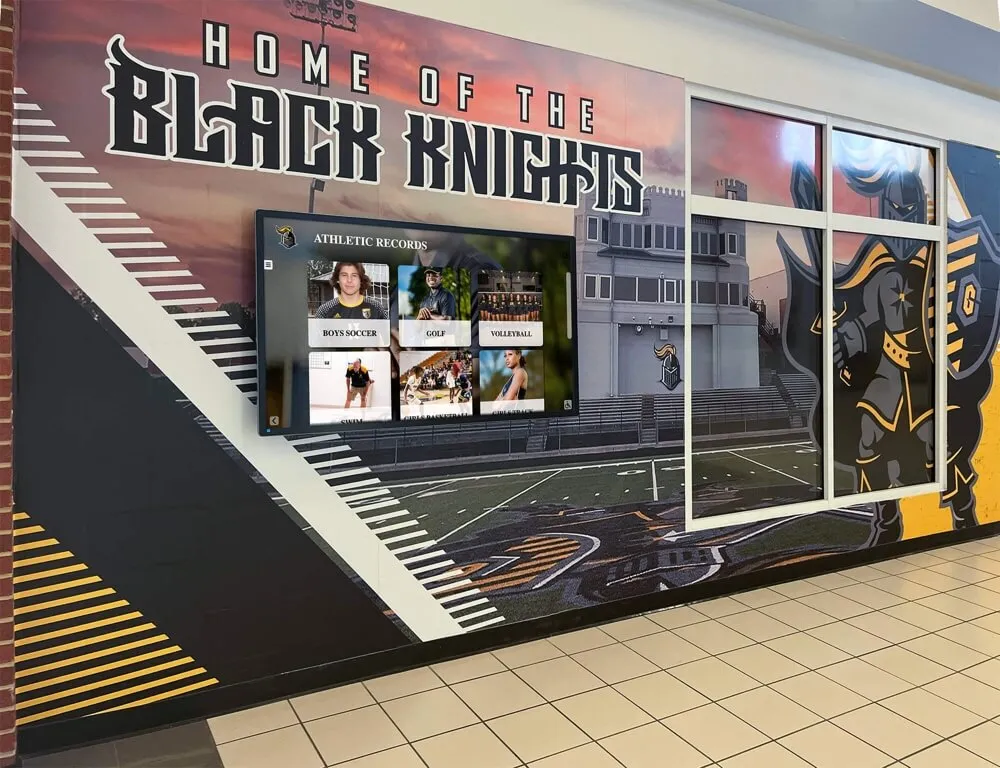
Implementing Digital Basketball Alumni Displays
Successful implementation requires systematic planning addressing content development, technology selection, and sustainable operations.
Phase 1: Planning and Content Strategy
Define Recognition Criteria:
Establish clear, transparent standards determining which alumni earn recognition:
- Achievement thresholds (e.g., 1,000 points, All-Conference selection, varsity letter winner)
- Character and conduct standards ensuring recognized individuals represent program values
- Team achievements worthy of collective recognition
- Special circumstance considerations for different eras
Clear criteria prevent confusion and ensure fair, consistent recognition decisions.
Content Research and Collection:
Gather existing materials documenting basketball history:
- Yearbook photos and rosters from school archives
- Local newspaper coverage from historical periods
- Existing record books and statistical documentation
- Alumni outreach requesting photos and information
- Coach interviews preserving institutional knowledge
- Social media appeals for community-contributed content
This research phase typically requires 40-80 hours for programs with extensive history but creates foundation enabling comprehensive recognition from implementation day one.
Organization and Categorization:
Develop logical structure organizing content for intuitive navigation:
- Chronological organization by graduation decade
- Achievement type categories (scoring, championships, All-State honors)
- Alphabetical athlete directories
- Team-based organization for championship squads
- Coaching era groupings
Phase 2: Technology Selection and Setup
Hardware Considerations:
Select appropriate display technology:
- Display Size: 43-65 inch touchscreens for hallway installations, 65-86 inch for gymnasiums and large spaces
- Orientation: Portrait (vertical) for individual athlete profiles, landscape (horizontal) for team displays and video content
- Commercial Grade: Purpose-built displays rated for 16-24 hour daily operation with 5-7 year lifespans
- Touch Technology: Responsive capacitive or infrared touchscreens supporting intuitive interaction
- Mounting: Wall-mounted for permanent installations or freestanding kiosk enclosures for flexible placement
Software Platform Selection:
Choose content management systems specifically designed for athletic recognition:
- Intuitive interfaces requiring no technical expertise
- Cloud-based architecture eliminating local server maintenance
- Pre-designed templates ensuring professional appearance
- Mobile access enabling updates from smartphones and tablets
- Analytics tracking engagement and usage patterns
- Integration capabilities with existing school systems
Solutions like Rocket Alumni Solutions provide purpose-built platforms designed specifically for school athletic recognition rather than generic digital signage requiring extensive customization.
Installation and Configuration:
Professional installation ensures optimal performance:
- Strategic placement in high-traffic areas (gymnasium lobbies, main hallways, athletic wings)
- Proper mounting at appropriate viewing heights
- Network connectivity for content updates and remote management
- Power supply with surge protection
- Initial content loading and system testing
- Staff training on content management
Phase 3: Content Development and Publishing
Creating Compelling Alumni Profiles:
Develop rich, engaging content for each recognized alumnus:
- Professional or action photos from playing careers
- Complete career statistics and season breakdowns
- Written narratives describing achievements and journeys
- Memorable game highlights and championship moments
- Quotes from athletes reflecting on experiences
- Current status and post-graduation accomplishments
Video Content Production:
Video dramatically increases engagement but requires thoughtful production:
- Alumni testimonial interviews reflecting on high school careers
- Game highlight footage from championships and record-breaking performances
- Team celebration videos from title celebrations
- Coach interviews providing context about athletes and eras
- Historical retrospectives connecting different program periods
Modern smartphones produce excellent video quality suitable for recognition displays when paired with basic accessories (tripod, external microphone, simple lighting). Focus on authentic storytelling rather than Hollywood production quality—genuine athlete reflections create stronger emotional connections than polished marketing content.
Phased Content Rollout:
Manage workload through systematic content development:
- Phase 1 (Month 1-2): Most recent 5-10 years where content readily available
- Phase 2 (Month 3-6): Previous decade requiring moderate research
- Phase 3 (Month 6-12): Historical eras requiring extensive research and outreach
- Ongoing: Continuous additions as alumni achievements occur and historical information emerges
This approach delivers immediate value while building comprehensive archives systematically rather than attempting overwhelming complete history documentation before launch.
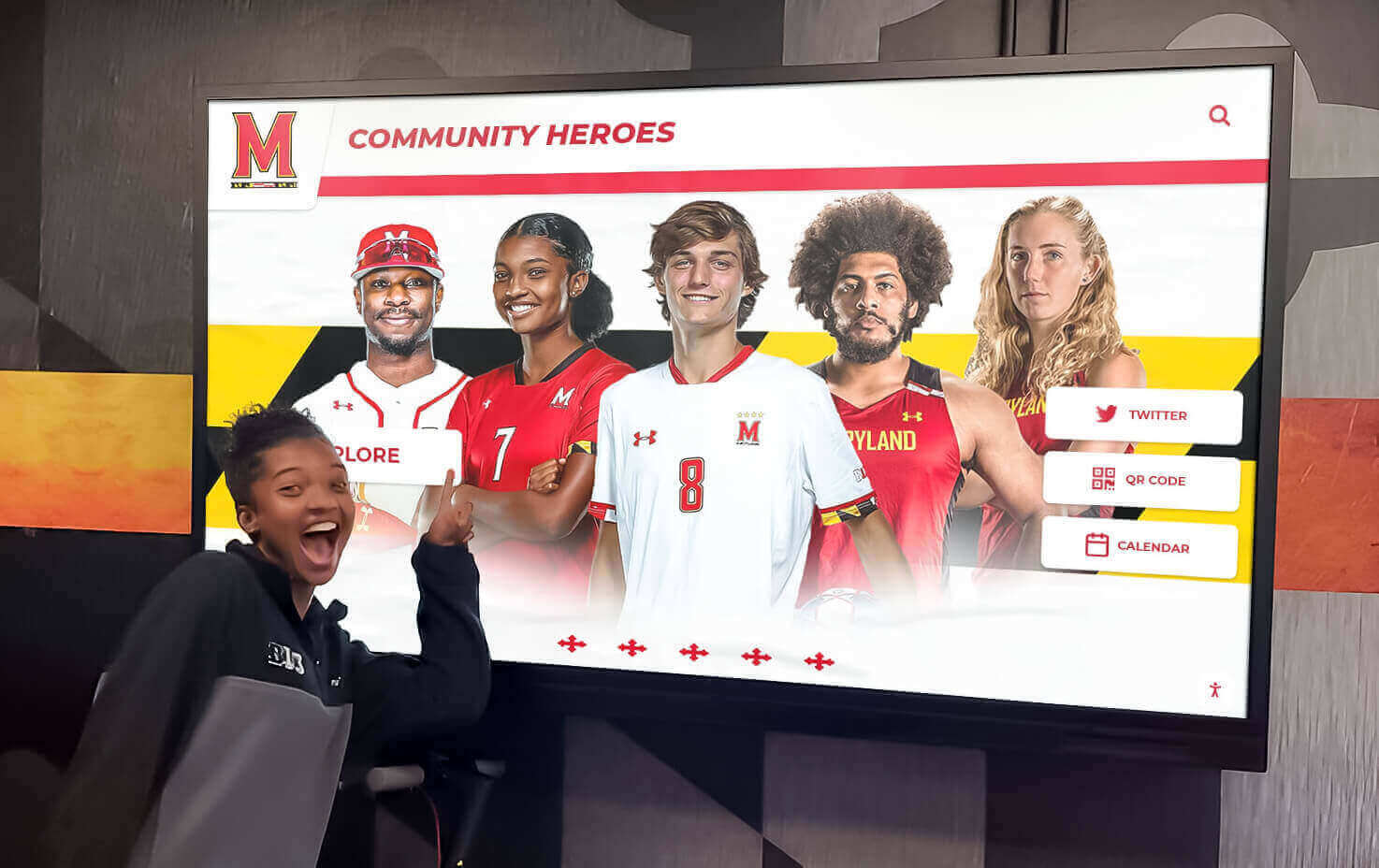
Maximizing Impact Through Strategic Placement and Promotion
Even excellent content fails to achieve impact if displays remain invisible or inaccessible. Strategic placement and active promotion ensure basketball alumni displays reach and engage target audiences.
Optimal Display Locations
Primary Installations:
- Gymnasium Lobbies: Natural gathering spaces where teams, families, and fans congregate before games create ideal primary locations with maximum visibility during basketball season
- Main School Entrances: High-traffic locations ensuring all students, staff, and visitors encounter displays regularly
- Athletic Department Areas: Hallways connecting locker rooms, weight rooms, and training facilities where current athletes spend significant time
- Cafeterias and Commons: Daily congregation spaces providing repeated exposure across entire school year
Secondary Installations:
Schools with larger budgets can extend recognition reach through additional displays:
- Team meeting rooms for focused engagement during practices and film sessions
- Alumni centers showcasing historical excellence for graduate visitors
- Administrative offices where recruits and families tour during campus visits
- Community spaces in town halls or recreation centers extending recognition beyond campus
Launch Events and Ongoing Promotion
Grand Opening Ceremonies:
Formal launch events generate excitement and awareness:
- Ribbon cutting with athletic directors, principals, and honored alumni
- Featured alumni speakers sharing experiences and program impact
- Media coverage from local newspapers and television stations
- Social media campaign highlighting display features and alumni stories
- Student assembly introduction explaining recognition and encouraging exploration
Continuous Promotion:
Sustain engagement through ongoing promotion:
- Regular social media posts featuring different alumni profiles
- Email campaigns to alumni highlighting new additions and updates
- Student announcements celebrating newly added recent graduates
- Incorporation into campus tours for prospective families
- Halftime recognition during games directing attention to displays
Alumni Reunion Integration:
Homecoming and reunion events provide natural opportunities:
- Guided tours of displays for returning alumni
- “Find yourself” campaigns encouraging alumni to locate their recognition
- Photo opportunities for alumni with their profiles
- Feedback collection about program history and missing content
- Social sharing campaigns extending digital reach
Schools implementing comprehensive promotion strategies report 3-5x higher initial engagement and sustained long-term usage compared to passive “install and forget” approaches that assume displays will organically attract attention without active awareness building.
Measuring Success and Demonstrating Value
Effective assessment demonstrates program value while identifying optimization opportunities.
Quantitative Engagement Metrics
For Digital Systems:
Modern platforms provide built-in analytics revealing interaction patterns:
- Usage Statistics: Total sessions, unique visitors, and average session duration
- Content Performance: Most viewed alumni profiles and video content
- Search Behavior: Common search queries indicating user interests
- Navigation Patterns: Page flows showing how visitors explore content
- Time Analysis: Peak usage times and days revealing optimal update timing
- Return Visitors: Frequency of repeat engagement demonstrating sustained interest
Benchmark Performance:
Typical engagement metrics for well-implemented systems:
- Average session duration: 4-6 minutes for engaged exploration
- Return visitor rate: 20-30% demonstrating sustained interest
- Video completion rate: 65-80% for 60-90 second content
- Social sharing: 15-25% of sessions include sharing activity
- Daily interactions: 75-200 sessions per display in high-traffic locations
Qualitative Impact Assessment
Athlete Perspectives:
Regular feedback from current players provides crucial insights:
- Awareness of specific alumni achievements and records
- Goal-setting influenced by visible recognition
- Program pride and identity connection
- Motivation to earn similar recognition
- Understanding of program traditions and history
Alumni Feedback:
Graduated player responses reveal recognition effectiveness:
- Satisfaction with how achievements are displayed
- Emotional connection to program through continued recognition
- Willingness to contribute photos, information, and support
- Frequency of sharing recognition with personal networks
- Return visit motivation for campus engagement
Recruitment Impact:
Prospect and family responses during campus visits:
- Impression of program professionalism and tradition
- Understanding of development pathways and achievement standards
- Comparison responses versus competing programs
- Questions generated about how to earn recognition
- Enrollment influence for border decisions
Return on Investment
Cost Analysis:
Compare traditional versus digital recognition approaches:
Traditional Approach (10-year period):
- 20 plaques at $300 each: $6,000
- Trophy case expansion: $3,000
- Annual maintenance and updates: $500 × 10 = $5,000
- Limited capacity forcing difficult choices
- Total: $14,000 with significant constraints
Digital System (10-year period):
- Initial hardware and installation: $8,000-15,000
- Annual software and support: $1,500 × 10 = $15,000
- Unlimited capacity with instant updates
- Total: $23,000-30,000 with dramatically superior capabilities
While digital systems require higher initial investment, they provide unlimited recognition capacity, instant updates eliminating recurring per-item costs, multimedia storytelling impossible with physical plaques, and analytics demonstrating engagement. Most schools achieve favorable cost-benefit within 5-7 years while enjoying vastly superior recognition capabilities from day one.
Intangible Value:
Many benefits resist quantification but deliver substantial value:
- Strengthened alumni relationships supporting fundraising and program development
- Enhanced recruitment through professional program presentation
- Preserved institutional history preventing permanent loss
- Improved program culture and athlete motivation
- Community pride and engagement around basketball excellence
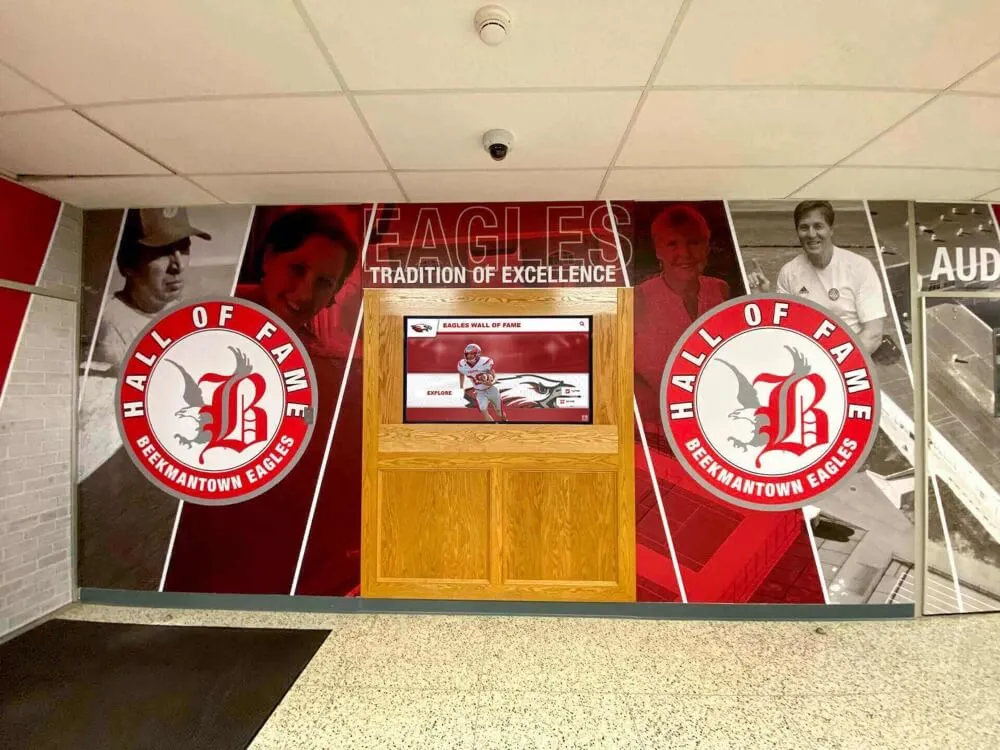
Best Practices for Sustainable Basketball Alumni Displays
Long-term success requires ongoing commitment to content quality, system maintenance, and continuous improvement.
Content Management Workflows
Responsibility Assignment:
Clear ownership prevents recognition from becoming neglected:
- Primary Administrator: Athletic director or coordinator with ultimate responsibility
- Content Manager: Staff member handling profile creation, updates, and quality control
- Media Coordinator: Individual capturing photos and videos at games and events
- Alumni Liaison: Point person for graduate outreach and information collection
Defined roles with specific accountability ensure basketball alumni displays remain current and valuable rather than becoming outdated after initial enthusiasm fades.
Update Schedules:
Regular content refreshes maintain relevance:
- Immediate: Championship celebrations and record-breaking performances
- Weekly (in-season): Statistical updates and current season highlights
- Monthly: New alumni profile additions and featured content rotation
- Quarterly: Comprehensive audits ensuring accuracy and identifying gaps
- Annual: Major content additions from yearbooks and end-of-season recognition
Quality Standards:
Maintain professional presentation:
- Consistent photo sizing, resolution, and styling
- Uniform biographical format across all alumni profiles
- Accurate statistical verification through multiple sources
- Professional writing tone and grammar
- Accessibility compliance for all users
System Maintenance and Technical Support
Hardware Care:
Proactive maintenance extends equipment lifespan:
- Weekly screen cleaning with appropriate materials
- Monthly ventilation inspection removing dust buildup
- Quarterly touch calibration ensuring accurate response
- Annual professional inspection of mounts and connections
Software Management:
Keep systems current and secure:
- Automatic platform updates from cloud-based providers
- Quarterly review of new features and capabilities
- Annual security audits and access control review
- Regular backup verification preventing data loss
Vendor Relationships:
Partner with providers offering sustained support:
- Responsive technical assistance via phone, email, and chat
- Regular check-ins ensuring system meets evolving needs
- Training for new staff as personnel changes occur
- Platform updates and feature additions
- Hardware warranty and replacement support
Solutions offering white-glove support from dedicated customer success teams distinguish quality vendors from those offering products without ongoing partnership.
Continuous Improvement Based on Feedback
Usage Analytics Review:
Regular analysis identifies optimization opportunities:
- Content receiving low engagement may need enhanced multimedia or improved descriptions
- High-traffic periods suggest optimal timing for featured content updates
- Popular search queries reveal user interests guiding content priorities
- Navigation patterns indicate confusing structures requiring reorganization
Stakeholder Feedback Collection:
Systematic input gathering:
- Annual surveys of current athletes about display awareness and impact
- Alumni feedback forms collecting satisfaction and content suggestions
- Parent and fan responses during events
- Coach observations about cultural impact on teams
- Staff input about ease of use and support needs
Iterative Enhancement:
Continuous improvement maintains program vitality:
- Address frequently requested content types or features
- Enhance underperforming content based on engagement data
- Expand recognition categories reflecting evolving program priorities
- Improve accessibility ensuring all community members can engage fully
Conclusion: Building Basketball Legacy Through Effective Alumni Recognition
High school basketball alumni displays serve vital purposes preserving program history, inspiring current athletes, and strengthening alumni connections that support program development for decades. Whether honoring championship teams, celebrating 1,000-point scorers, recognizing All-State athletes, or documenting complete program history, effective displays transform abstract achievements into tangible inspiration that motivates next generations while honoring those who built basketball traditions.
Traditional physical recognition approaches—plaques, trophy cases, banners—provide permanent visibility but impose significant constraints through limited space, high per-item costs, minimal information capacity, and time-consuming update processes. These limitations force schools to make difficult choices about which achievements receive recognition and which remain undocumented.
Modern digital basketball alumni displays eliminate these constraints while introducing capabilities impossible with conventional methods. Unlimited recognition capacity ensures every deserving athlete receives appropriate celebration. Instant updates enable real-time recognition when achievements occur. Rich multimedia content creates engaging storytelling bringing alumni to life through photos, videos, statistics, and personal narratives. Interactive exploration invites active discovery rather than passive viewing.
Successful implementation requires systematic planning addressing content research and development, appropriate technology selection, strategic placement for maximum visibility, ongoing content management ensuring freshness, and regular assessment demonstrating value while identifying improvement opportunities.
The most effective programs integrate basketball alumni recognition within comprehensive athletic recognition celebrating excellence across all sports. Digital platforms excel at this integrated approach because unlimited capacity prevents competition for finite space—basketball legends receive rich profiles alongside football record holders, championship teams from every sport, and distinguished athletes regardless of their focus area.
Whether implementing recognition for the first time, modernizing outdated systems, or expanding existing programs, basketball alumni displays represent investments in program culture delivering returns for decades through preserved legacy, motivated athletes, and engaged communities celebrating court excellence. Schools ready to transform basketball recognition should explore how purpose-built solutions from Rocket Alumni Solutions enable comprehensive alumni displays that honor the past while inspiring the future through professional, engaging platforms designed specifically for educational athletic recognition.
Basketball programs build legacies through athletes who dedicate years to their craft while creating memories that last lifetimes. Effective alumni displays ensure these contributions receive the lasting recognition they deserve—connecting past legends with current competitors and future stars in continuous traditions of basketball excellence that define programs and inspire communities.
